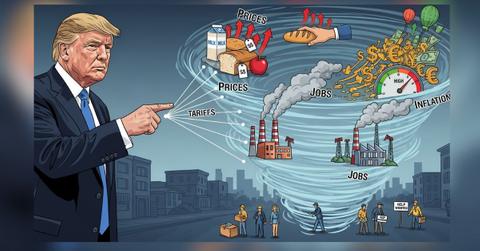 NEWS
NEWSHow Trump's Tariffs Could Affect Everyday Americans — Prices, Jobs, and Inflation

Nov. 5 2025, Published 1:33 a.m. ET
When it comes to Trump’s tariff policies, everyday Americans are likely to feel the impact now more than ever. In the future, whether they are buying groceries or driving their car, or even when working on the assembly line, these tariff policies will force our way of life.
While tariffs are often described as a measure to "protect American jobs," in fact the potential adverse effects ripple across wide areas and a number of industries unrelated to the original target. It might affect ordinary citizens. Further, let’s take a look at how Trump's tariffs could have affected everyday Americans.
1. Higher Prices for Everyday Goods
Tariffs act as a tax on imported products. When the U.S. imposes tariffs on goods from other countries, especially China, American importers have to pay more for those goods. Instead of absorbing those costs, most companies pass them on to consumers.
From a legal viewpoint or to connect with lawyers who are specialists in trade law or consumer interests, you may consider taking help from FindTheLawyers as they will provide appropriate legal advice.
Tariffs on imported goods have a direct impact on everything importation, from technology to clothes and home essentials. With higher production and import costs, consumer prices also rise in multiple categories. This even further minimizes the household budgets.
- Electronics: Smartphones, laptops, and televisions often contain Chinese-made components. Tariffs increase production costs, pushing prices higher.
- Clothing and footwear: Many U.S. brands manufacture apparel overseas. Tariffs can raise retail prices by 10–25%.
- Household essentials: From washing machines to furniture, tariffs raise costs for middle-class families already struggling with inflation.
2. Inflation Could Climb Further
The U.S. economy is already experiencing upward price pressures. New tariffs may well only serve to aggravate this trend by raising the price of imported materials and finished products. Businesses which must pay more for their materials from steel and aluminium to plastic parts for electronic products, usually pass along those increases in their own costs.
It means fresh eggs, wallboard, or auto parts are going to get pricier-just making it even more hard on consumers since 2021.
3. Impact on Jobs and Wages
Trump’s tariffs are designed to boost American manufacturing employment. But the outcome can be mixed.
- Short-term gains: With U.S. producers more competitive, some industries, such as steel and aluminum, might see temporary boosts.
- Long-term strain: Many small manufacturers depend on imported parts. Tariffs increase their costs and they can't afford to keep all their staff, freeze wages, or even shut down.
Workers in industries like automotive, construction, and agriculture could see job insecurity if tariffs disrupt supply chains or reduce exports.
Want OK! each day? Sign up here!
4. Retaliation Could Hurt U.S. Exports
When the U.S. imposes tariffs, other countries often retaliate with their own tariffs on American products. During the last trade war, China targeted U.S. agriculture, hurting farmers who relied on exports of soybeans, pork, and corn.
A renewed tariff war could again hit rural America, driving down farm incomes and forcing the government to issue subsidies to offset losses.
5. The Hidden Cost: Slower Economic Growth
When the United States imposes tariffs, other countries will also set up their own duties on American products. During the last trade war, China chose to attack U.S. agriculture. Farmers who had long relied on the exports of soybeans, pork and corn felt the pinch.
Once again a tariff war could slam rural America, drive down the incomes of farmers, make the government have to dole out subsidies to make up for loss.
Conclusion: The Real Cost of “America First”
While tariffs may sound like a strong strategy to protect American industries, the hidden costs often land on ordinary families. Rising prices, job uncertainty, and persistent inflation all take a toll on household budgets.
The tariff war isn’t just about global economics. It’s about the day-to-day lives of Americans trying to afford groceries, gas, and a stable future.


